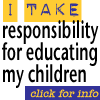
What about the poor?Marshall FritzWill the poor children be left behind if we return to Honest Education? It is precisely the poor, socially deprived children who are most injured by the current system. The kids from stable families in well-off neighborhoods believe the promises of future success offered by school-by-government. To these youngsters, economic success can seem a sufficient substitute for the lack of Honest Education. They expect success, so they can adapt to schooling that is all about success, not truth. Poor children?especially those from broken homes, or worse, those whose fathers were like sperm donors who haven't seen their children even once?these children with no aces in their hands know their odds of success are much longer; for some, virtually impossible. Hence, they can only regard schooling that promises success as a sucker's deal, a swindle to keep them quiet in their misery. They, most desperately of all, need answers to the most basic human questions: "Why do I exist?" "Where am I ultimately going?" "What's the point?" Answers to these questions are necessary if youngsters are going to accept the deferred gratification of studying reading, writing, and quadratic equations. Many education researchers have studied the gap between inner-city children who attend "public schools" vs. religious schools. They study the effect of better discipline, uniforms, class size, teacher training, and a hundred matters, but how often do they consider whether addressing serious issues of origins, purpose, and destiny makes a difference? Answering these questions gives children a dignity otherwise denied them, and thus the courage it takes to learn. On the other hand, government schools are disastrous for the poor because they avoid the Big Questions of Life, as they must to avoid turmoil and lawsuits. What about the poor? [more]by Chris Cardiff In various forms, the question "what do we do about the poor?" outstrips all others as the most frequently asked question about separating school and state. The implicit assumption, only natural after 60 years of the welfare state and 150 years of government control of education, is that government is the only entity capable of looking out for the poor and educating them. Both the historical record and present conditions invalidate this assumption. There is no evidence that poor children were denied an education in the nonslave states before the government takeover of the schools in the mid-1800s. Since then, educational opportunities for the poor have declined steadily. While government control of education harms all families, children of low-income families are damaged most severely. Our inner-city government schools resemble prisons with their metal detectors and armed guards on patrol. Described as "poverty mills" by critics, these institutions cannot educate; they can only warehouse children. Despite spending over 300 billion taxpayer dollars on education every year, our existing system of government schools is not meeting the needs of low-income families. The full separation of school and state means rescinding government-compelled attendance, curriculum, credentialing, accreditation, and financing. The issue of providing educational opportunities for the poor hinges on financing. Restated, the question becomes: how will low-income families be able to afford education for their children without government handouts? The second-largest entitlement program in the worldWith expenditures of over $316 billion per year, education is the second-largest entitlement program in the United States (and the world), ranking behind Social Security but ahead of Medicare-Medicaid.[1] Providing educational opportunities for low-income families can be met without edu-welfare by replacing the government educational dole with a system of private scholarships (or private vouchers) funded by charitable donations. As part of the movement toward a free market in education, dozens of private scholarship foundations for elementary and secondary school-age children have proliferated since J. Patrick Rooney, chairman of Golden Rule Insurance, inaugurated the first one in 1991. These charity-financed programs encourage family involvement with their children's education and schools by requiring participating families to choose a school that matches their needs and to pay part of the tuition themselves. These programs are successfully providing the means for over 10,000 children to attend independent schools today. Is it realistic to expect them to replace our gigantic edu-welfare system? How much money would these programs need to help all low-income families? The answer is, comparatively, very little. Running the numbersA simplified static analysis of educational funding requires two numbers: how many children (or families) will need financial assistance to attend independent schools, and how much will it cost them? As a rough estimate, one-third of families?16 million children?will need financial assistance. Half of these, eight million, are classified as "poor" by the U.S. Census Bureau, while the other half could be considered lower middle-class. According to the National Center for Educational Statistics, private school tuition averages between $2,500 and $3,000 per year. A typical private scholarship program provides up to half (some pay more than half, most have ceiling amounts). For this simplified static analysis, assume $1,500 scholarships ? half the cost of the upper end of the range. (It's easy to improve on this model by developing a sliding scale of scholarships based on financial need, ranging, for example, from $750 to $2,250 but averaging $1,500). If all 16 million poor and lower-middle-class children were provided a $1,500 scholarship, educational opportunities in today's independent schools could be opened for all low-income families for only $24 billion. To put that amount in perspective, it is 25 percent less than the state of California alone spends and less than 8 percent of the $316 billion spent on education today by all levels of government nationwide. Where will the money come from?We have a long history of charitable giving in this country. While many charities have been co-opted and crowded out by government, Americans still give generously of their time and money. Consider these statistics:
All this is on top of an average tax burden of over 40 percent. Clearly, we are a generous nation, a giving people ? and much of our largess is directed toward providing educational opportunities for others. With donors already contributing $37.3 billion for higher education, how difficult would it be to raise the $24 billion needed for private scholarships for elementary and secondary school-age children? A recent example illustrates the credibility of this scenario. Last August, a local judge shut down much of Milwaukee's school-choice program (based on government vouchers) after thousands of children had already begun classes. A generous outpouring by Milwaukee's citizens resulted in raising $1.6 million in ten days (and eventually more than $2 million) so that the children could remain in the schools they chose and not be forced to return to government schools.[7] It's not a question of whether Americans will support private scholarships for elementary and secondary school children ? obviously, they already do. The dynamics of a free market and a $316 billion tax cutEliminating government's role in education eliminates the need to tax citizens to fund the government schools. That even suggests a natural course of action to begin separating school and state. Taxes could be phased out, allowing the private sector to grow over time. Families could pay tuition bills with funds previously taken as taxes. Others have called for an immediate repeal of all taxes that fund schools. Imagine the possibilities of returning $316 billion to taxpayers as part of separating school and state! Currently only 12 percent of America's school-aged children attend independent, parochial, or home schools.[8] Making this market eight times larger would spur educational innovation as entrepreneurs chased those dollars. Educational opportunities would expand tremendously for everyone ? especially the poor. The quantity and quality of educational opportunities would increase dramatically. Finally, consider the possibilities for raising $24 billion for private scholarships from taxpayers who have just had $316 billion returned to them. If only eight percent of that money found its way to private scholarship funds, money would be available for all children of lower-income families to attend better schools than they are attending today. In the dynamic real world, much less would be needed, as families learned to become independent again. Not only is it likely that private funding for scholarships would be available for lower-income families, but those dollars would also be purchasing a much better educational product. Given these synergistic benefits, the only question remaining is: what are we waiting for? 1. Government's elementary and secondary schools spend $249 billion. That includes $211 billion of per-pupil costs, $27 billion in capital outlay and interest, $2 billion from U.S. Department of Education, $3 billion from other federal programs, and $6 billion of additional state expenditures. Myron Lieberman, Public Education: An Autopsy (Cambridge, Mass.: Harvard University Press, 1993), pp. 114-142. In the 1992-1993 school year, federal, state, and local governments provided $66.6 billion to colleges and universities. Chronicle of Higher Education Almanac, September 1, 1995, p. 25. 2. Kim Dennis, "The History of Social Assistance," National Leadership Conference, March 29, 1995. 4. "Sources of Voluntary Support for Higher Education, 1993-1994," Chronicle of Higher Education Almanac, September 1995, p. 25. 5. The private sector controls and awards $24.9 billion. Database Survey, National Scholarship Research Service, December 1991. This survey result is independently corroborated by data reported in Foundation Giving (New York: The Foundation Center, 1994), p.10, and in The Chronicle of Philanthropy (April 1990). Some $9.1 billion is controlled and awarded by schools. The Digest of Education Statistics 1994 (U.S. Department of Education, National Center for Education Statistics), p. 321, table 313. Figures are for academic year 1991-1992. 6. John Hood, "When Business 'Adopts' Schools: Spare the Rod, Spoil the Child," Cato Institute Policy Analysis, June 5, 1991, p. 5. 7. "School Wars," editorial, The Wall Street Journal, September 11, 1995, p. A16. 8. The Digest of Education Statistics 1990 (U.S. Department of Education, National Center for Education Statistics), p. 51, table 37, and p. 68, table 53. Figures are for academic year 1987-1988. This article first appeared in Ideas on Liberty, a publication of the Foundation for Economic Education. Used by permission of the author.
[top] |

